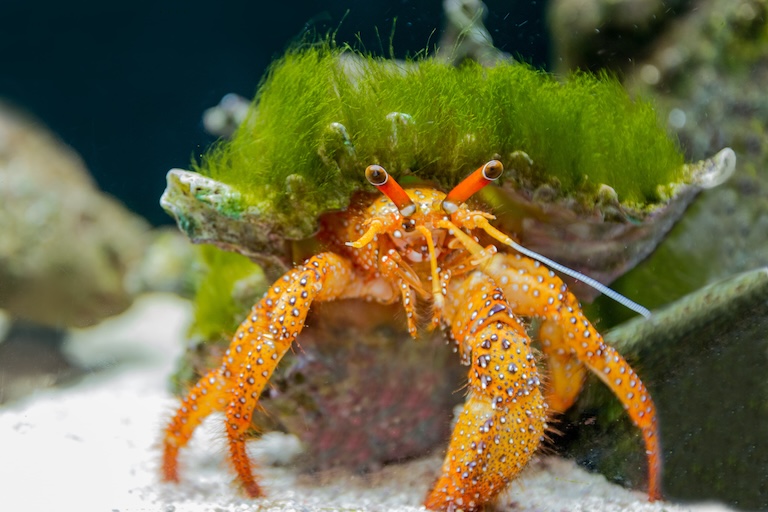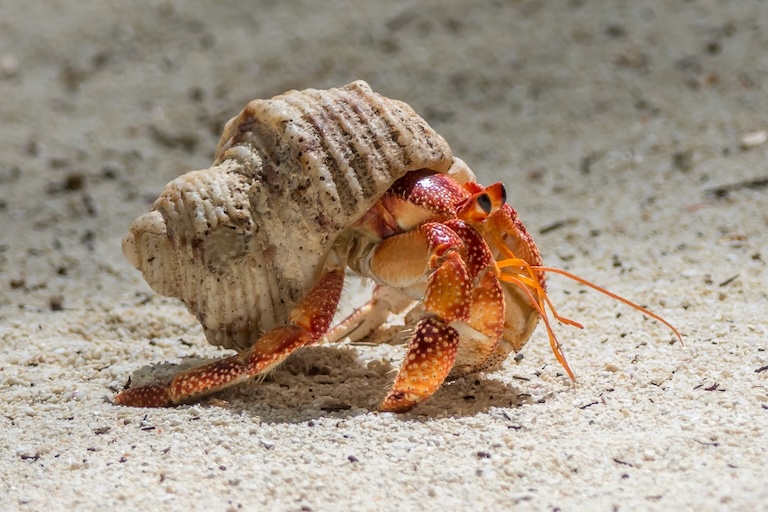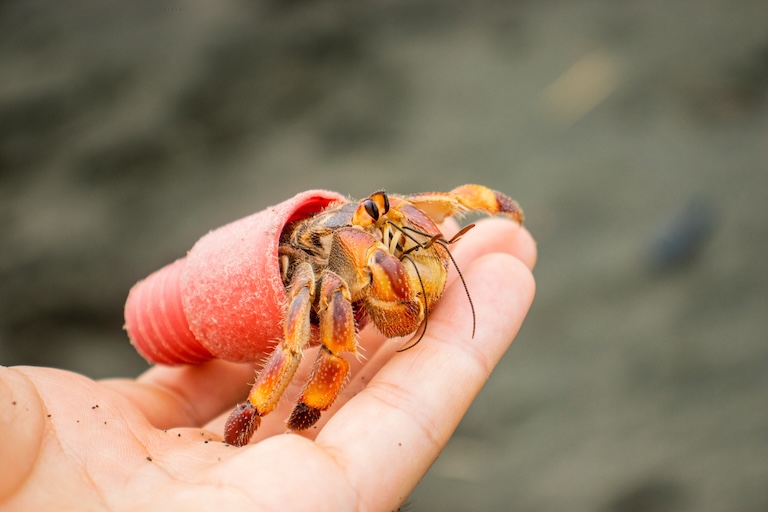Hermit Crabs Profile
Some tens of millions of years ago, a hard-shelled crustacean took advantage of all the shells molluscs leave behind when they die and came up with an ingenious strategy: save resources on growing your own and just use all the leftover ones kicking around.
This may have been a great way to avoid being swept up in any number of mass die-offs that have occurred over the years, reducing their metabolic needs while exploiting all the carnage.
Even today, this seems to be a common theme for hermit crabs, who are making the most of all the plastic junk we’re throwing into the oceans while everything else chokes to death.

Hermit Crabs Facts Overview
| Habitat: | Marine and terrestrial |
| Location: | Worldwide, more prominent in the tropics and subtropic regions |
| Lifespan: | Up to 70 years, maybe more |
| Size: | 12mm (0.5 in) to 1.8m (6 ft) long |
| Weight: | 4+ Kg (9lb) in large species |
| Colour: | Varied across hundreds of species |
| Diet: | Omnivorous scavengers |
| Predators: | Birds, fish, octopus, other crustaceans |
| Top Speed: | Slow |
| No. of Species: | 1,200 |
| Conservation Status: | Most not listed, Coconut crab is Vulnerable (IUCN) |
Hermit crabs are not crabs, and they probably don’t appreciate being called one, but they are good at dressing like one, though not the first to do it.
Being able to borrow shells is helping them pretty well, and they can be found pretty much all over the world.
Further, while shells are getting softer as oceans acidify, these adaptable animals are moving into our discarded junk.
Interesting Hermit Crabs Facts
1. They’re not crabs
The world of marine crustacean nomenclature is, quite frankly, one of disrespect.
This is not you’re regular Eskimo/Innuit confusion, there are animals out there named after entirely separate orders.
If you think it’s rude to confuse the Chinese with the Japanese, imagine confusing one of them for a gibbon.
That’s the level we’re dealing with here; crabs and hermit crabs are differentiated at the superfamily level, which means they’re both crustaceans, they’re both decapods, and they’re both members of the Pleocyemata suborder, which they share with lobsters, shrimp, crayfish and squat lobsters (which are also not lobsters), among others.

2. They’re not the first
While they are distinct, they’re not original. Long before hermit crabs, or even regular crabs, evolved, penis fish were sheathing themselves in a similar way.
Around 500 million years ago, penis worms invented the hermit life, employing the discarded shells of their peers for that added layer of protection from chafing, as well as the onslaught of predator diversity around the Cambrian explosion, which pushed them to seek shelter.
The researchers established that Cambrian predators were plentiful and aggressive, that forced the penis worms to move into empty shells, leading to the invention of ‘hermit’ lifestyle. 1
3. They can be tiny
An Ecuadorian hermit crab is thought to be the world’s smallest: it’s just over a centimetre long, and while tiny, these little critters have surprising longevity.
The oldest on record was said to have lived to 32 years and had been kept as a pet.
The majority of species commonly found around beaches are no more than 2 to 4cm and can be found around the coastline, but there are some species that are significantly larger and can even be found in the house. 2
4. Or giant
On the other end of the spectrum, hermit crabs can be pretty huge. Some of the largest include the appropriately named giant hermit crab, and the coconut crab, the latter of which climbs into people’s dustbins and steals meat from their kitchens.
This monster can have a leg span of up to a metre and weigh more than 4kg.
5. They can be left or right-handed
There are four families of hermit crabs, each with a little quirk. The Diogenidae are one family, commonly called the left-handed hermit crabs on account of their hands being different sizes.
In this family, it’s the left claw that’s bigger, but the Coenobitidae, their close relatives have larger claws on their right hand, so you can guess what they’re called.
The third family, the Paguridae, are just called hermit crabs, and that’s partly because some have big left hands and others have big right ones, but for all three families, this is a general trend, rather than a rule and there are exceptions, which can make identifying them a bit frustrating.
But the fourth family is nice and easy to spot.

6. Some are kings
If we are to include the left and right-handed hermit crabs in part of the wider “hermit crab” net, we have to include the closest relatives of the Paguridae: the king crabs.
King crabs are closer related to the Paguridae hermit crabs than they are to the left and right-handed families, yet they look nothing like any other in the group.
They are, of course, not real crabs, but often gargantuan crustaceans, with a leg span of up to 1.8 metres across. They look a lot like spider crabs (which are true crabs), don’t borrow shells, and have a spiny carapace with long, gangly legs.
Despite looking and behaving entirely differently, their relationship with the hermits seems to be backed up by anatomical features that all in the subfamily share. Still, their position is subject to change and has flipped back and forth in recent years, so watch this space.
7. They can live on land
That meat thief we mentioned is one of the few species of hermit crab that can live on land. While they spend their larval stages in the water, as adults they lose the ability to swim and move up onto shore.
Instead of gills, they have special lungs for air breathing, which allows them to come well inland, where they can be a bit of a pest.
Some even say they’ll eat a person if the opportunity presents itself, and some go as far as to suggest that’s exactly what happened to Amelia Earhart. 3
8. They wear our trash
Ocean plastic is a catastrophic problem for much of the world’s marine life. It clumps together to form large floating toxic waste islands and gets lodged into the nostrils of turtles or snags and drowns dolphins.
On the whole, wildlife is struggling, but hermit crabs seem to be making the best of it. They can be found inside bottle caps, lightbulb fittings, and various other junk we’ve put out there, and as far as we can tell this isn’t harming them, though there may be cases of crabs getting trapped.
That’s not to say we should keep doing this, as even with the handful of species thriving amid the destruction, this is not a net gain for anyone, and pollution is still a serious threat. But it does go to show how some species adapt to even the most destructive of ecological changes. 4

Hermit Crabs Fact-File Summary
Scientific Classification
| Kingdom: | Animalia |
| Phylum: | Arthropoda |
| Class: | Malacostraca |
| Order: | Decapoda |
| Family: | 4 families |
| Superfamily: | Paguroidea |
Fact Sources & References
- (2021), “New study finds ‘hermit crab’ lifestyle first invented by penis worms”, Durham University.
- “Hermit crab”, Scottish Wildlife Trust.
- Andrew Daniels (2023), “Was Amelia Earhart Eaten by Crabs?”, Popular Mechanics.
- Victoria Gill (2024), “Hermit crabs are ‘wearing’ our plastic rubbish”, BBC.
